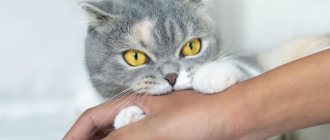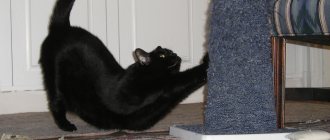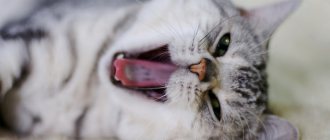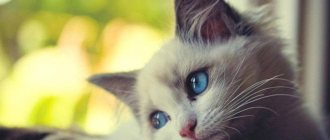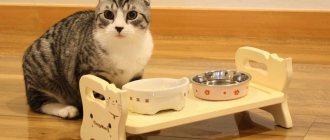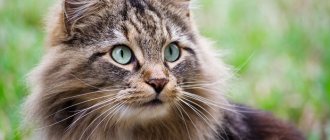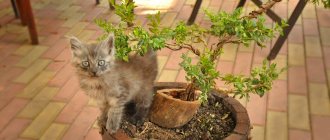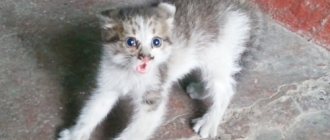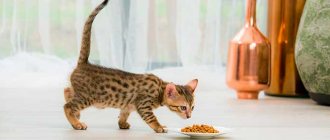How to stop a cat from eating indoor flowers? Why do cats show interest in flowerpots? These questions are often asked on forums by owners of furry pets or those who are just planning to get a kitten. Indeed, it is not entirely pleasant when a cat happily gnaws leaves and buds of indoor plants grown with great love, or even more so goes to the toilet in a flower pot.
Throwing a slipper at a pet, rude shouts, reproaches and even physical force do not always give a positive result.
Therefore, in order to wean a cat from this harmful habit, you need not only to approach the training process responsibly and with great patience, but also to understand why your beloved pet shows interest in flower pots and gnaws on house plants.
Why do cats eat plants and greens?
Cats are predators by nature. The basis of their diet is meat products. In their natural environment, cats feed on small rodents and birds. Since animals eat their prey whole, along with hair and bones, undigested food debris accumulates in the gastrointestinal tract, which is not subject to the action of digestive enzymes. Therefore, cats eat grass and plants to cleanse the digestive tract . The blades of grass irritate the gastric mucosa, provoking a gag reflex.
In addition, cats constantly lick and groom their fur. “Wool” lumps accumulate in the stomach. And to cleanse themselves of this “ballast”, cats also resort to the help of plants. This is a natural physiological process and since animals, unlike humans, cannot control and suppress the instincts inherent in nature, they show interest in decorative indoor flowers.
Some plants, herbs, greens, which cats are partial to, not only cleanse the stomach and intestines of undigested food particles and hairballs, but also help normalize digestion, eliminate constipation, neutralize toxins if the animal is poisoned, and also saturate the body with useful substances.
Each cat has its own preferences regarding plants. Some pets love sprouted oats, others happily gnaw on soft violet leaves and eat hibiscus and anthurium flowers. As a rule, cats most like to gnaw on flowers that resemble grass (dracaenas, chlorophytums, narrow-leaved palms). In addition, small kittens and even adult pets use the leaves that hang down as toys.
If a domestic cat likes to dig in flowers and happily eats leaves of indoor plants, this may be due to the following reasons:
- hypovitaminosis;
- banal harmfulness;
- boredom, lack of attention;
- metabolic disorders;
- invasive diseases (helminthiasis);
- poisoning;
- constipation;
- perverted appetite (parorexia);
- compulsive disorders;
- accumulation of a large amount of wool in the stomach;
- disruption of digestive processes.
Important! If a cat happily gnaws on the greens of house plants, it may not be receiving enough nutrients, vitamins, and amino acids from the food, which can cause hypovitaminosis.
Sometimes cats start nibbling flowers, digging in flower pots, or defecating in flowerpots out of spite. Thus, furry pets try to attract attention to themselves. The pet may not be comfortable with its litter tray or its location in the house or apartment.
Small kittens tend to damage flowerpots out of curiosity. By testing plants by their teeth, they study the world around them. In addition, kids are incredibly curious, playful and inquisitive. Therefore, indoor flowers, especially hanging plants and vines, can attract them in the form of toys.
What to do if your cat eats flowers
If a cat eats indoor flowers, then in order to wean him from this activity, which irritates many housewives, you can try different methods. Moreover, all cats are individual; if one method works well for a certain pet, this does not mean at all that it will work for all cats. Let's look at them in more detail:
- If a cat begins to eat indoor flowers, then he will do this until he finds a more suitable alternative for these purposes. To meet his needs, you can get special grass, for example, oats, wheat, barley, millet, catnip. Cats often switch to this type of greenery growing in your home.
- In order to wean your cat from eating flowers, you can try placing them out of the animal’s reach.
- In order to wean your cat from eating flowers, you can add objects with strong odors to the pots. Citrus peels placed in a pot are well suited for these purposes. Especially cats, with their delicate noses, cannot stand the smell of lemon peels. Instead of citrus peels, you can put cloves of garlic or onion in a flower pot. Also, if you treat the edges of a flower pot with vinegar, then it will not go near it for a long time, since this smell is quite pungent for the animal. To repel with smell, you can try using any perfume, because not everything that people like will appeal to a cat.
- If a cat has ever used a potted flower to go to the toilet, then it will be quite difficult to wean it off, because the smell of urine will attract it again and again. If you use commercially available repellent sprays, this can have a bad effect on the flowers. You can try scattering shells and pebbles on the surface of the earth in a flower pot. You can use fiberboard sheets, cut in a semicircle and placed deep into the pot. This will take away the smell of earth that is so attractive to the cat.
- If your cat eats flowers due to a lack of vitamins and microelements, then you can try to balance your pet’s food. It would be good to introduce carrots, cabbage, parsley, cucumbers into it, which will not only help preserve the life of indoor flowers, but also introduce iodine, vitamins into the animal’s body, and will also help in the fight against helminths. Which vegetable your pet will prefer can only be determined by trial.
Other reasons
It also happens that cats eat decorative flowers due to obsessive-compulsive disorders. If a pet is obsessed with chewing, constantly chews something, drags it into its mouth, sucks on various objects (cotton, fabrics, cotton wool, rags, soft toys) - this indicates that the animal suffers from obsessive-compulsive disorder . As a rule, a similar condition is noted in Burmese, Abyssinian, Siamese, and exotic cats. Unfortunately, it is not always possible to stop this behavior, so if you encounter a similar problem, contact a veterinary specialist (veterinary behaviorist).
If a cat constantly eats inedible objects with pleasure, chews electrical cords, walls, paper, wallpaper, ropes, and the ground, and at the same time does this constantly and with great pleasure, most likely the pet suffers from parorexia (perverted appetite).
This phenomenon can be caused by severe stress, emotional tension, genetic predisposition, congenital anomalies, but you need to understand that such behavior is very dangerous for the health and life of the cat. Foreign objects can clog the intestinal lumen, damage the mucous membrane of the gastrointestinal tract, causing acute inflammation, and cause poisoning and intoxication.
If your pet suffers from parorexia, we recommend reducing the number of indoor flowers in the house or removing them altogether.
Problems from eating flowers
Cats hardly think about the fact that house plants can poison them. However, vegetation on windowsills contains dangerous toxins that are harmful to cats.
- The well-known geranium can cause extensive gastrointestinal upset in pets, which will lead to digestive problems in the future.
- The harmless ficus can burn the stomach lining and damage the pet's kidneys.
- Chrysanthemums are strong allergens. A cat, having eaten such a flower, may immediately fall and convulse. At the same time, the pet vomits and its breathing worsens.
You are not alone with the problem of flower-eating cats. Many people are trying to solve this problem, and some of them manage to do it quickly and without problems. Remember: by forbidding your cat to eat flowers, you do not take away happy moments from him, but increase them.
Why you need to stop your cat from eating indoor flowers
Some ornamental green plants are very poisonous to cats. Geranium, galanthus, cala, spatephyllum, asparagus, cyclamen, ivy, ficus, some types of dracaena are unsafe for furry pets. Pollen from tulips, hyacinths, daffodils, and other flowers causes severe allergies in cats. Hydrangea provokes acute indigestion, vomiting, abdominal cramps, and helleborus disrupts the heart rhythm.
Despite the fact that cats are very selective in food, a small kitten, due to inexperience, having tasted a poisonous plant, can become seriously poisoned.
No less dangerous for animals are the products used to control pests of indoor flowers, as well as fertilizers for foliar feeding.
Some plant species are deadly to animals. In addition to intoxication, substances contained in poisonous flowers inhibit the functioning of the cardiovascular system and respiratory center, provoke muscle spasms, paralysis of muscle structures, and anaphylactic shock.
Many types of ficus cause burns to the mucous membrane of the stomach, oral cavity, and larynx, provoke acute inflammation in the digestive tract, and lead to damage to the liver and kidneys.
Therefore, if you have a cat at home, consult with your veterinarian which indoor plants pose a danger to pets.
Why do cats eat flowers?
Despite the fact that cats belong to the order of carnivores, they are not averse to eating greens. Barnacles eat green leaves because:
- Their diet lacks essential nutrients: vitamins, folic acid, fiber.
- They are necessary to cleanse the intestines of undigested food debris and swallowed wool.
- Greens stimulate the gag reflex. If a cat is poisoned or has worms, it eats shoots and leaves, causing vomiting to cleanse the digestive tract of toxins, parasites and their eggs.
- They are curious and prefer to study the object of interest not only by smell, but also by taste. If the plant does not cause any unpleasant sensations or is liked, then it will be impossible to hide it from the cat.
- They want to attract the owner's attention by demonstratively eating their favorite flower.
- They experience stress and thus relieve tension.
- Sick - with pancreatic insufficiency, gastritis, pancreatitis, stimulate intestinal motility. It can also be caused by certain infectious diseases (for example, viral feline leukemia) or mental disorders.
To find out which of the reasons was the impetus for the damage to indoor plants, you should observe your pet and consult a veterinarian.
Indoor plants that are dangerous to the health of cats.
Spoiled plants not only bring grief to the owner. They can become a source of serious poisoning for your pet.
Therefore, until the owner weans the cat from chewing plants, the following should be removed from the windowsills:
- hyacinths;
- lilies;
- geranium;
- dieffenbachia;
- monstera;
- caladium;
- ivy (all varieties);
- Euphorbia (euphorbia);
- ficus;
- hydrangea;
- cyclamen;
- violets.
Wild and garden flowers. You need to select flowers in a bouquet with caution. Cut flowers are just as enticing to cats as potted plants. You should not arrange bouquets from:
- snowdrops, even the water in the vase becomes poisonous;
- tulips and lilies - the pollen of these flowers is also dangerous, which can stain the cat’s fur and get into the esophagus during the toilet;
- lilies of the valley;
- chrysanthemums
It is worth keeping a close eye on your pet when taking it out to the countryside or nature. There are many plants that are deadly to cats.
What to do if a cat spoils house plants
It is necessary to instill in a cat the correct manners of behavior from an early age gradually but persistently. The cat must understand what he is allowed to do and what he is not allowed to do.
When weaning your pet from bad habits, including eating indoor flowers, never resort to physical violence, rudeness, or screaming. This approach will only aggravate the situation and will not achieve the desired result.
Cats not only do not understand rudeness, but they can also do things to spite you in the future, and at the same time they will play pranks in your absence. Raising animals requires consistency, patience, and perseverance.
Advice! Unlike dogs, raising a cat is much more difficult with prohibitions and punishments. It is much easier to “agree” with a cat or outsmart him.
To wean your cat from eating indoor plants, digging up soil in flowerpots, turning over flower pots, you need to make flowers unattractive to your pet or block access to flowers.
Place plants that your pet is particularly interested in out of the reach of your cat. Buy special stands for flowerpots and hanging flowerpots. Place pots of flowers on cabinets, under the ceiling. Of course, in this case, it is possible that the cat will not be able to get to the flowers. The forbidden fruit is sweet and cats are very inventive animals, so the pet will try to get to the flowers through curtains, carpets, and furniture. But still, try to create the safest possible environment for your pet.
To wean your cat off from eating flowers, lubricate the leaves, flowers, and trunks of plants with lemon juice, hot pepper, and other non-toxic products that have a pungent odor and unpleasant bitter taste. The leaves can be treated with garlic water. Having tasted a treated “inedible” plant, the animal will lose interest in the flower. Near the flowers, place peels and slices of citrus fruits, the smell of which cats cannot stand.
To discourage a cat from climbing into flower pots, place bowls with essential oils or repellent sensors on the windowsills that react to movement and produce a sound that is unpleasant for cats. There are also special “repellents” for cats in aerosols and sprays that can be used to spray flower pots.
Important! When processing plants, use only products that are safe for animals and plant flora. It is strictly forbidden to use medications, chemicals, or toxic substances.
If a cat approaches a flowerpot, scare the pet with a sharp sound, clap your hands, and spray the pet with water from a spray bottle. The effect of surprise works very well on cats. Frightened, the cat will associate flowers with something “scary” and unpleasant.
If a cat has gotten into the habit of relieving itself in flowerpots, it will not be easy to wean him off this habit. The smell of feces will constantly attract your pet, so completely change the soil in the flower and transplant the plant into another pot. To prevent the cat from going to the toilet in flowers in the future, or digging the soil in flowerpots, add a layer of gravel, small pebbles, and shells on top of the soil. You can use sprays with cat repellent scents.
Reasons that motivate a cat to eat flowers
To wean a cat from eating flowers, you need to understand the reason that prompts it to these actions:
- Cats need plants for better digestion of food. From time to time, substances enter their digestive tract that interfere with the full functioning of the gastrointestinal system. If a cat is an outdoor cat, then it consumes its prey along with feathers and bones; when it licks itself, it ends up with a lot of fur in its body. In order to regurgitate all unnecessary substances, she eats plants.
- If your cat eats plants, then most likely she has a vitamin deficiency.
- The grass helps the cat balance the amount of oxygen in the blood.
